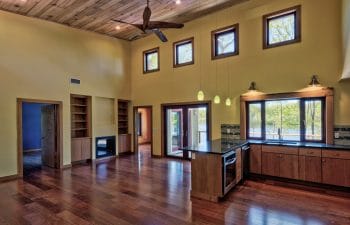
We’re sure many of you have heard of the saying “think global, act local.” Of course, this sentiment can have a multitude of different meanings depending upon interpretation—but at its core, it means that none of us on earth exist separately from others. Regardless of how you look at it, the statement has generational implications… whatever decisions we make today will affect not only our families and communities, but our local and global environments long after we are gone.
This idea is highly relevant to sustainable architecture and ecological design. Even some of the most environmentally minded individuals don’t necessarily see the importance of building green. Educating people on the importance of sustainable architecture and demonstrating the value of sustainable solutions to existing structures are two important steps in guiding individuals in the right direction to help overcome traditional notions.
Climate Change Threatens Our Way Of Living
In major cities, councils have been formed to find solutions for impending changes in our climate. Locally, in Boston, the sea level is predicted to rise 40 inches by 2070, putting over 6,500 parcels at risk of being partially swallowed by the sea (Pearson, 2020). 90% of the buildings that will make up the New York City Skyline in 2050 are already built—and their carbon footprint is troubling to say the least (The Architectural League NY, 2019). Nationally, by 2100 coastal cities like Miami and New Orleans face the potential of a six-foot sea-level rise, and cities that lie in severe heat zones like Chicago face life-threatening heat waves (Bendix, 2019).
Globally, arctic ice sheets are dissolving at alarming rates, resulting in sea levels rising so much that they threaten to consume many of the worlds’ most populated areas. Indonesia, India, and Bangladesh are already dealing with the consequences of rising sea levels, while summer temperatures in cities within the Persian Gulf such as Dubai and Abu Dhabi could result in temperatures so high that they will be nearly uninhabitable by 2070 (Bendix, 2019). Aside from the terrifying impact on wildlife and ecosystems, these changes threaten humankind in ways never before imagined.
We Need To Act Now – Our Future Depends On It!
Years like 2050, 2070, and 2100 sound like the distant future, so there is often a disconnect between decisions made today and how it could affect the environment within our (and our families) lifetimes. Let’s take a step back to put this in perspective: The time between 1990 and now is the same timespan between now, and 2050. For those of us who were around in the 90’s, we would probably all agree that it doesn’t seem like thirty years ago. Importantly, as humans we need to understand that regardless of our perception of time, our actions today truly impact the world of tomorrow. Essentially, the future is now and decisions we make today that may seem insignificant at the time can create a ripple effect into the future of our local and global environments.
Alfandre Architecture Is Passionate About Sustainable Building
At Alfandre Architecture we design and build locally but are always mindful of the impact of those buildings on our global footprint. Our decisions relating to architecture result in products that will be here long after we are gone. Chuck Palahniuk once said, “We all die. The goal isn’t to live forever, the goal is to create something that will.” Though that statement is pertinent to a wide range of applications, such as art, literature, and music, it is also highly relevant to architectural design because our buildings and structures are almost always guaranteed to outlast not only ourselves, but generations to come.
With that in mind, it’s considerably difficult to move forward with any architecture project without being mindful of the environment that is guaranteed to change within the next 30, 50, or 80 years. We’re in a climate crisis, and the ecosystems and environments across the world are all drastically changing in ways our planet has never seen. All structures we design and build are created to be maximally energy-efficient, climatically responsive, and solar ready. The construction systems we use minimize energy requirements resulting in an overall reduction of the use of fossil fuels. We are LEED certified and are always mindful of the impact on the site/location, water and energy efficiency, material selection, and indoor air quality when approaching a project.
Designing and Green Building For The Future With Alfandre Architecture and Eco Builders
We offer a unique package to clients where we can both design and build a project. Together with Eco Builders, Inc. (our general contracting firm), we seamlessly take care of everything from design concept to handing over the keys when the project is completed. Both Alfandre Architecture, PC and Eco Builder’s Inc. specialize in sustainable building and generational design, so by opting for our Design/Build package, it ensures that the structure is intrinsically designed with sustainability in mind, and the materials used for building are eco-friendly.
Importantly, our approach applies to existing structures as well. If you are looking into buying a house or a building that is already standing, we can plan a sustainable retrofit (or restorative design) to make it more eco-friendly and cost effective. We care about the environment and are well aware of the changing climate. Our responsibility as architects and builders is to ensure that the structures we create exist harmoniously within their respective environments.
We are able to give our clients the peace of mind that their project is high quality, built to last, and environmentally conscious.
Importantly, we are making decisions today, for tomorrow.

References
Bendix (2019). Scientists say these 11 major cities could become unlivable within 80 years. Business Insider.
Pearson, C. (2020). Boston pushes flood resilience with new design guidelines. Building Green.
To combat climate change, focus on existing buildings (2019). The Architectural League NY.

